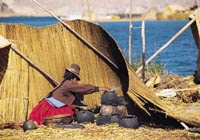Colca Canyon, one of the two deepest in :Peru, is famous for sighting the condor.
What a beautiful bird! This is what the National Geographic Society says about them:
"Andean condors are massive birds, among the largest in the world that are able to fly. Because they are so heavy (up to 33 pounds/15 kilograms), even their enormous 10-foot (3-meter) wingspan needs some help to keep them aloft. For that reason, these birds prefer to live in windy areas where they can glide on air currents with little effort. Andean condors are found in mountainous regions, as their name suggests, but also live near coasts replete with ocean breezes and even deserts that feature strong thermal air currents.
"These condors are mostly black, but males have a distinctive white "collar" around their necks and some white markings on their wings as well. Like their relatives, the California condors, Andean condors have bald heads.
"Condors are vultures, so they keep their sharp eyes peeled for the carrion that makes up most of their diet. They prefer to feast on large animals, wild or domestic, and in picking the carcasses, they perform an important function as a natural clean-up crew. Along the coasts, condors will feed on dead marine animals like seals or fish. These birds do not have sharp predator's claws, but they will raid birds' nests for eggs or even young hatchlings.
"These long-lived birds have survived over 75 years in captivity, but they reproduce slowly. A mating pair produces only a single offspring every other year, and both parents must care for their young for a full year.
"The Andean condor is considered endangered but is in far better shape than its California cousin. Perhaps a few thousand South American birds survive, and reintroduction programs are working to supplement that number."
There are actually 14 towns throughout the length of the valley and they have kept their religious festivities and folk art and music, so there is plenty to see there if you go at the right time. Our new website will give more details. the surrounding landscape includes the Hualca-Hualca, Ampato and Sabancaya volcanoes.
Here are another couple of views of the valley:
And then there's this:
Here's a view of the Ampato volcano:
And here's the Sabancayo:
Colca Canyon is 11,154 feet deep and is just an amazing experience.




.jpg)









































